A variety of roofing systems are available for commercial roofing. In addition cost, longevity, and long term maintenance are dependent on a number of influences and are extremely customized to each building. In terms of cost, there are many factors that play in to the types of commercial roofs that can increase or decrease the overall expenditure. For example certain roof types needs insulation applied first, the number of layers that need to be applied, what type of existing roofs are there (tear off or not), what type of decking is there, etc. Many systems come with a 20-year warranty if the system is installed on the bare roof deck.
Types of Commercial Flat-Roof Systems
Asphalt or Built-Up Roof
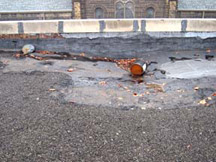 This is the most traditional of the types of commercial roofs. It is made up of hot asphalt and often covered with gravel. However, there are more advanced forms of materials that do not require a gravel coating. If not applied properly it can be difficult to create a proper seal at all seams and connection points. Improper installation can cause many roofs to leak early on requiring more maintenance and repairs.
This is the most traditional of the types of commercial roofs. It is made up of hot asphalt and often covered with gravel. However, there are more advanced forms of materials that do not require a gravel coating. If not applied properly it can be difficult to create a proper seal at all seams and connection points. Improper installation can cause many roofs to leak early on requiring more maintenance and repairs.
The structure of the building may need to be reinforced as this type of roof can be quite heavy. Repairs for asphalt roofs with gravel are time consuming due to the fact that the gravel can hide any suspect leak areas. A layer of gravel on an asphalt roof does help with to deflect UV exposure, lends weight to the roofing material to keep it in place, and acts as a fire retardant. A building with windows that overlook a portion of gravel roof can have a more attractive view of river rock gravel rather than just a black rubber. But keeping the drains and gutters free of gravel is an essential piece to maintaining this roof type.
Asphalt roof material was fairly inexpensive in the past but has been increasing in terms of cost over the years due to the price of oil. This type of commercial roof will typically last 10 to 25 years or more if properly maintain. However, many factors (including but not limited to weather, sun exposure, application, decking, roof slope, and traffic on the roof) can affect its longevity.
Rubber or EPDM
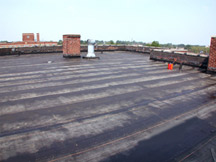 EPDM is made mostly of flat synthetic rubber pieces that are welded together at the seams to form one continuous membrane. This material resists expansion and contraction and reflects UV rays. Even though this type of material is light and thin, it is attached directly to the roof decking which eliminates the need for gravel or weight to hold it down. This type of roof will last typically 10 to 25 years or more if properly maintained but many factors including but not limited to weather, sun exposure, application, decking, roof slope, and traffic on the roof.
EPDM is made mostly of flat synthetic rubber pieces that are welded together at the seams to form one continuous membrane. This material resists expansion and contraction and reflects UV rays. Even though this type of material is light and thin, it is attached directly to the roof decking which eliminates the need for gravel or weight to hold it down. This type of roof will last typically 10 to 25 years or more if properly maintained but many factors including but not limited to weather, sun exposure, application, decking, roof slope, and traffic on the roof.
Thermoplastic Membranes
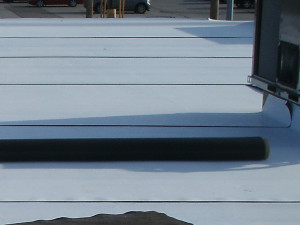 The most common material used for this type of roof is TPO although there are others available such as PVC. TPO sheets are typically white which helps to reflect UV rays and are made with flame retardants, UV absorbers for those rays not deflected, and other properties to increase longevity of the material. It can be fully adhered to the roof decking, mechanically fastened or ballasted. Depending on the application and amount of flashing detail on the roof the TPO roof can be the most cost effective. This type of roof will last typically 10 to 25 years or more if properly maintained but many factors including but not limited to weather, sun exposure, application, decking, roof slope, and traffic on the roof.
The most common material used for this type of roof is TPO although there are others available such as PVC. TPO sheets are typically white which helps to reflect UV rays and are made with flame retardants, UV absorbers for those rays not deflected, and other properties to increase longevity of the material. It can be fully adhered to the roof decking, mechanically fastened or ballasted. Depending on the application and amount of flashing detail on the roof the TPO roof can be the most cost effective. This type of roof will last typically 10 to 25 years or more if properly maintained but many factors including but not limited to weather, sun exposure, application, decking, roof slope, and traffic on the roof.
Modified Bitumen
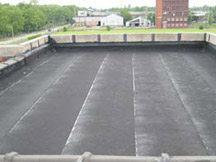 This type of roofing is an evolution of asphalt roofing and is also referred to as APP or SBS. It is made from asphalt with a mineral-based wear surface and a variety of modifiers and solvents. Modified bitumen roofing materials resist expansion and contraction and reflect UV rays. There are several ways of connecting pieces of this material. In a torch application process the sheets are heated to melt the asphalt together and create a seal. There is also a cold-applied adhesive application process, and some self-adhesive forms of this system. Another application of this material is done with hot asphalt. In terms of material this can be slightly more expensive than the other materials available. This type of roof will last typically 10 to 25 years or more if properly maintained but many factors including but not limited to weather, sun exposure, application, decking, roof slope, and traffic on the roof.
This type of roofing is an evolution of asphalt roofing and is also referred to as APP or SBS. It is made from asphalt with a mineral-based wear surface and a variety of modifiers and solvents. Modified bitumen roofing materials resist expansion and contraction and reflect UV rays. There are several ways of connecting pieces of this material. In a torch application process the sheets are heated to melt the asphalt together and create a seal. There is also a cold-applied adhesive application process, and some self-adhesive forms of this system. Another application of this material is done with hot asphalt. In terms of material this can be slightly more expensive than the other materials available. This type of roof will last typically 10 to 25 years or more if properly maintained but many factors including but not limited to weather, sun exposure, application, decking, roof slope, and traffic on the roof.
Metal
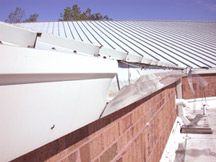 This type of roof comes in a variety of materials such as coated galvanized steel, stainless steel, copper, aluminum, lead, tin, and more. Metal roofs are durable in colder climates and nowadays the material is normally recycled. Insulation application is an important factor to consider because metal roofs are conductors of high heat. Maintenance is essential as metal is susceptible to rust and due to the rising costs of precious metal it may also be susceptible to metal thieves. There are several types of coatings that can extend the life of a metal roof such as anti-rust, waterproofing, and heat reflective coatings. Metal roofs can vary in cost largely dependent on the material but have the same life expectancy of other roof types as long as it is properly maintained.
This type of roof comes in a variety of materials such as coated galvanized steel, stainless steel, copper, aluminum, lead, tin, and more. Metal roofs are durable in colder climates and nowadays the material is normally recycled. Insulation application is an important factor to consider because metal roofs are conductors of high heat. Maintenance is essential as metal is susceptible to rust and due to the rising costs of precious metal it may also be susceptible to metal thieves. There are several types of coatings that can extend the life of a metal roof such as anti-rust, waterproofing, and heat reflective coatings. Metal roofs can vary in cost largely dependent on the material but have the same life expectancy of other roof types as long as it is properly maintained.
Call the roofing experts at Reader
Reader Roofing has three generations of experience in all types of commercial roofs. If you have questions on commercial roofing, contact us to speak with one of our roofing experts.


You must be logged in to post a comment.